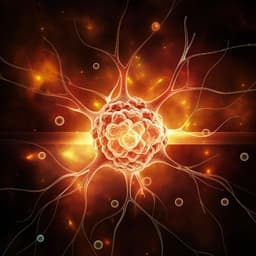
Medicine and Health
Mitochondrial dysfunction-targeting therapeutics of natural products in Parkinson's disease
T. He, X. Lin, et al.
Discover groundbreaking insights into Parkinson's disease and the potential of natural products as therapeutic agents for mitochondrial dysfunction, as explored by Ting He, Xiaoyan Lin, Anping Su, Yujie Zhang, Zhichao Xing, Li Mi, Tao Wei, Zhihui Li, and Wenshuang Wu.
~3 min • Beginner • English
Introduction
The paper addresses the growing burden of Parkinson’s disease (PD), which affects 0.1%–0.2% of the general population and ~1% of those over 60. Despite current pharmacological (e.g., levodopa, dopamine agonists, anticholinergics) and non-pharmacological treatments (surgery, exercise), long-term side effects and inability to halt disease progression remain challenges. PD pathology features dopaminergic neuron loss, α-synuclein aggregation (Lewy bodies), and mechanisms including mitochondrial dysfunction, oxidative stress, and neuroinflammation. Given mitochondria’s central role in neuronal energy homeostasis and evidence linking mitochondrial dysfunction (ATP depletion, elevated ROS, apoptosis, impaired biogenesis/dynamics/mitophagy) to PD, the study aims to review natural products that target mitochondrial dysfunction as potential PD therapeutics and summarize their mechanisms of action.
Literature Review
The review synthesizes evidence on mitochondrial roles in PD (respiration, ATP generation via ETC complexes I–V, ROS production, dynamics, biogenesis, and mitophagy). It compiles studies on diverse natural products—flavonoids, polyphenols/phenols, terpenoids, glycosides, quinones, alkaloids, and complex plant extracts—that ameliorate mitochondrial dysfunction in PD models. Across cellular and animal PD models (e.g., SH-SY5Y, SK-N-SH, PC12, BV-2, N27 cells; rotenone, MPTP/MPP+, 6-OHDA, paraquat; Drosophila and rodent models), these compounds improve bioenergetics (restore MMP, increase ATP, enhance ETC complex activities), reduce oxidative stress (lower ROS), normalize dynamics (downregulate Drp1, upregulate Mfn1/2), promote biogenesis (SIRT1/AMPK/PGC-1α→Nrf1/2→TFAM→mtDNA/COX1), augment mitophagy (PINK1/Parkin, LC3-II increase, p62 decrease), and inhibit apoptosis (Bcl-2 up, Bax/Cyt-c/caspases down). Table 1 details models, doses, and mechanistic readouts for representative compounds.
Methodology
Comprehensive literature search of original publications from 2012 to 2022 across PubMed, Web of Science, Elsevier, Wiley, and Springer, focusing on studies of natural products that counter PD by restoring mitochondrial dysfunction. The review collates mechanistic and efficacy data from in vitro and in vivo PD models, summarizing mitochondrial targets: respiration/bioenergetics, biogenesis/mitophagy, dynamics, and apoptosis. Specific inclusion/exclusion criteria beyond databases, timeframe, and focus were not detailed.
Key Findings
- Natural products improve mitochondrial respiration and bioenergetics in PD models:
- Flavonoids: Naringenin (10–80 μM, 2 h pretreatment) rescued MMP, ATP, and complex I/V in MG-challenged SH-SY5Y; 80 μM improved MMP/ATP in paraquat-treated SH-SY5Y; 40 mg/kg protected paraquat-exposed rats. Calycosin (up to 400 μM in Drosophila feed) increased ATP and MMP; nobiletin restored complexes I–IV and MMP in LPS-exposed BV-2 cells; silibinin restored hippocampal MMP in MPTP mice; baicalein (10 μM) restored MMP in SH-SY5Y and protected mice (5 mg/kg) against rotenone; hyperoside maintained MMP and lowered ROS in SH-SY5Y; quercetin (10 mg/kg) reduced ROS and increased mitochondrial SOD in aluminum-treated rats. Myricitrin (0.1–10 μM) increased ATP/MMP, decreased ROS via AGE/RAGE/NF-κB. Icaritin improved nigral energy metabolites and mitochondrial proteins (SDHA, VDAC, ATP5B) in MPTP mice.
- Phenols/polyphenols: Resveratrol lowered ROS, increased complex I and citrate synthase activities, basal O2 consumption, ATP, and MMP; curcumin (50–200 mg/kg) rescued complex II activity in rotenone mice; curcumin (2 μM) increased MMP and spare respiratory capacity in paraquat-treated SH-SY5Y (including PINK1 knockdown). Mangiferin (2.5–40 μg/mL) increased MMP/ATP in vitro; 10–40 mg/kg improved mitochondrial integrity in MPTP mice. Demethoxycurcumin, paeonolum, α-arbutin prevented MMP loss and reduced ROS. Sativex increased complex II activity and complex IV protein in mice. Oleuropein increased ATP and lowered ROS in glutamate-treated HT-22 cells. Polydatin raised MMP and reduced ROS in rotenone-exposed or Parkin-deficient cells.
- Terpenoids: Ginsenoside Re reversed complex IV deficits in PINK1-null cells by elevating complex IV assembly factors (LRPPRC, Hsp90, Hsp60). Ursolic acid (5–10 mg/kg) prevented rotenone-induced complex I inhibition. Celastrol (1–10 nM) prevented MMP loss and reduced ROS. Mogroside V increased MMP/ATP and OCR, reduced ROS, linked to SIRT3 upregulation.
- Glycosides: Echinacoside attenuated 6-OHDA-induced MMP decrease in PC12 cells. Astragalus polysaccharide maintained MMP and reduced ROS; cordycepin increased MMP/ATP/complex I and reduced ROS.
- Quinones: Anthraquinone (50 nM) restored MMP in 6-OHDA-treated cells. Embelin (5 μM) increased basal OCR and ATP in N27 cells.
- Plant extracts: Multiple extracts (e.g., Bacopa monnieri, Centella asiatica, Eucommia ulmoides, Ganoderma lucidum, Morinda citrifolia, cocoa, tomato seeds, saffron, Selaginella delicatula, Mucuna pruriens, Artemisia argyi) restored MMP, reduced ROS, and enhanced ETC complex activities (e.g., Bacopa preserved complex I in cells and complexes II–III in mice; tomato seed extract restored complexes I–II and II–III; Centella increased complex I and reduced ROS; Morinda increased complex I/IV).
- Natural products promote mitochondrial biogenesis and mitophagy:
- Resveratrol (20–25 μM) increased PGC-1α activity, TFAM/COX1 expression, mtDNA/nDNA ratio; elevated LC3-II and reduced p62, augmenting autophagic flux. Vanillic acid increased PGC-1α and TFAM mRNA, mtDNA copy number, and mitochondrial mass. Urolithin A increased LC3-II, PINK1/Parkin, decreased p62. Polydatin increased LC3-II. Ursolic acid (10 mg/kg) upregulated COX1. Embelin increased mtDNA, pAMPK, SIRT1, PGC-1α, and Nrf1/2/TFAM. Silibinin (280 mg/kg) increased PTEN-PINK1/Parkin expression; baicalein increased LC3B-II; calycosin reduced p62 and mTORC1 readouts (p-S6K, p-4EBP1).
- Natural products rebalance mitochondrial dynamics:
- Silibinin decreased Drp1 and increased Mfn1 in MPTP mice hippocampus. Resveratrol reduced short/fragmented mitochondria in rotenone-treated cells. Oleuropein reduced fragmented mitochondria via Drp1 Ser637 phosphorylation. Mangiferin inhibited MPTP-induced Drp1 translocation and normalized mitophagy proteins (PINK1, Parkin, NIX, BNIP3, FUNDC1, p62). Plant extracts (cocoa, Artemisia argyi, Mucuna pruriens, Decalepis hamiltonii) modulated Fis1/Drp1 and Mfn2 and reduced mitochondrial fragmentation.
- Natural products inhibit mitochondrial apoptosis:
- Flavonoids (baicalein, quercetin, naringenin, calycosin) decreased Bax, Cyt-c release, and caspase-3/9, increased Bcl-2. Phenols/polyphenols (oleuropein, mangiferin, green tea polyphenols, demethoxycurcumin) showed similar anti-apoptotic profiles. Mogroside V reduced Cyt-c release and caspase-3 activity. Astragalus polysaccharide increased Bcl-2 and decreased Bax/Cyt-c/caspase-3. Alkaloids (piperine, piperlonguminine) lowered cytosolic Cyt-c. Isolongifolene reduced Bax and caspase activation, increased Bcl-2 in rats. Many plant extracts modulated Bcl-2 family proteins and caspases.
- Safety/toxicology overview: Many compounds showed favorable safety at studied doses (e.g., baicalein up to 2800 mg single oral dose in humans; silymarin up to 700 mg TID for 24 weeks). Potential adverse effects at higher doses or specific compounds include quercetin mutagenicity and pro-oxidant metabolites; high-dose curcumin apoptosis in normal cells; resveratrol nephrotoxicity and GI issues; ursolic acid liver enzyme elevations; piperine hepatotoxicity; anthraquinone organ toxicity in rodents; embelin reversible liver/kidney changes at high doses in rats.
Discussion
The compiled evidence supports the central hypothesis that targeting mitochondrial dysfunction is a viable therapeutic strategy in PD and that natural products can modulate key mitochondrial pathways. By improving bioenergetics (MMP, ATP, ETC activity) and reducing oxidative stress, these agents address early pathogenic events in dopaminergic neurons. Their capacity to normalize mitochondrial dynamics (Drp1/Mfn1/2), enhance biogenesis (SIRT1/AMPK/PGC-1α→TFAM), and promote mitophagy (PINK1/Parkin, LC3-II up, p62 down) further supports mitochondrial quality control, potentially reducing α-synuclein aggregation and neuronal loss. Anti-apoptotic effects (Bcl-2 up, Bax/Cyt-c/caspases down) directly counteract intrinsic mitochondrial apoptosis implicated in PD neurodegeneration. Collectively, the multi-target actions of natural products align with PD’s multifactorial pathology, underscoring their relevance as lead compounds or adjuvants for PD therapy.
Conclusion
Natural products show substantial promise as therapeutics for PD by targeting mitochondrial dysfunction across multiple axes—respiration/bioenergetics, dynamics, apoptosis, biogenesis, and mitophagy. Both purified compounds (flavonoids, polyphenols, terpenoids, glycosides, quinones, alkaloids) and complex plant extracts demonstrate neuroprotection in diverse PD models. However, gaps remain, particularly limited in-depth studies on dynamics, biogenesis, and mitophagy, and challenges in defining structure–activity relationships across diverse scaffolds. Future work should emphasize mechanistic studies, optimization (including semi-synthesis) to enhance stability and dosing control, and rigorously designed clinical trials to establish safety and efficacy in humans.
Limitations
- Evidence base is predominantly in vitro and animal models; few clinical studies in PD patients.
- Variability in preparation, dosing, and composition (especially in plant extracts) limits reproducibility and dose standardization.
- Potential off-target effects and toxicities exist; some compounds exhibit dose-dependent adverse effects.
- Limited mechanistic depth for mitochondrial dynamics, biogenesis, and mitophagy relative to respiration and apoptosis.
- Difficulty establishing clear structure–activity relationships due to structural diversity and heterogeneous experimental models.
Related Publications
Explore these studies to deepen your understanding of the subject.







